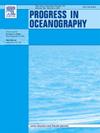Water column structure influences variability of micronekton distribution and biodiversity in the California Current
IF 3.6
3区 地球科学
Q1 OCEANOGRAPHY
引用次数: 0
Abstract
Vertical water column characteristics are important features for understanding pelagic species’ distribution patterns, although they are rarely included as covariates in model-based abundance indices derived from fisheries-independent surveys. The mixed layer depth (MLD) is one such metric of the physical water column structure that could improve model-based estimates of abundance. In eastern boundary upwelling systems, water column stratification alters abiotic parameters, including temperature and availability of nutrients and light, above and below the MLD, potentially impacting the distribution and concentration of zooplankton and micronekton. To evaluate the role of MLD on individual species abundance and community biodiversity metrics, we examined 34 years (1990–2023) of catch and hydrographic data from a fisheries-independent midwater trawl survey of the epipelagic micronekton in the California Current. While global ocean models project a shoaling of the MLD with long-term ocean warming, we found no trend in MLD through time in our study area. However, we did find significant relationships between the abundance, or presence, of several species (krill, young-of-the-year [YOY] northern anchovy, YOY Pacific hake, adult Pacific sardine, YOY sanddabs, sergestid shrimp, and YOY widow rockfish), and overall species richness with MLD, which indicates that the catchability of some species may be influenced by the vertical water column structure. Additionally, we used auxiliary depth-stratified tows to assess vertical catch distributions and found significant relationships between trawl depth and species abundance and richness. Thus, accounting for MLD may reduce uncertainty in indices developed for both stock assessments and ecosystem status reports, as well as provide insights into the potential impacts of climate change on survey procedures.
水柱结构影响加利福尼亚海流微浮游生物分布和生物多样性的变化
垂直水柱特征是了解远洋物种分布格局的重要特征,尽管它们很少作为协变量包括在基于模式的丰度指数中,这些丰度指数是由渔业独立调查得出的。混合层深度(MLD)是物理水柱结构的一种度量,可以改进基于模型的丰度估计。在东部边界上升流系统中,水柱分层改变了MLD上下的非生物参数,包括温度、营养物质和光照的可用性,潜在地影响了浮游动物和微浮游生物的分布和浓度。为了评估MLD对个体物种丰度和群落生物多样性指标的作用,我们研究了34年(1990-2023)加利福尼亚海流上层微孔鱼的捕捞量和水文数据。虽然全球海洋模式预测长期海洋变暖会使MLD变浅,但我们发现研究区域的MLD没有随时间变化的趋势。然而,我们确实发现了一些物种(磷虾、年轻的北方凤尾鱼、太平洋鳕鱼、成年太平洋沙丁鱼、沙刺鱼、sergestid虾和YOY widow rockfish)的丰度与总体物种丰富度与MLD之间的显著关系,这表明某些物种的可捕性可能受到垂直水柱结构的影响。此外,我们使用辅助深度分层拖网来评估垂直渔获分布,发现拖网深度与物种丰度和丰富度之间存在显著关系。因此,考虑最大存储量可以减少为种群评估和生态系统状况报告制定的指数的不确定性,并有助于深入了解气候变化对调查程序的潜在影响。
本文章由计算机程序翻译,如有差异,请以英文原文为准。
求助全文
约1分钟内获得全文
求助全文
来源期刊

Progress in Oceanography
地学-海洋学
CiteScore
7.20
自引率
4.90%
发文量
138
审稿时长
3 months
期刊介绍:
Progress in Oceanography publishes the longer, more comprehensive papers that most oceanographers feel are necessary, on occasion, to do justice to their work. Contributions are generally either a review of an aspect of oceanography or a treatise on an expanding oceanographic subject. The articles cover the entire spectrum of disciplines within the science of oceanography. Occasionally volumes are devoted to collections of papers and conference proceedings of exceptional interest. Essential reading for all oceanographers.
 求助内容:
求助内容: 应助结果提醒方式:
应助结果提醒方式:


